Case Studies # 1 Neuropathy of Hands & Feet after Cancer Treatment
- J., 57 years old, Female
Presenting symptoms
Bilateral numbness and tingling of hands and feet, SOB on exertion, dry cough, chronic fatigue, urgency in urination and defecation, perennial pain, anxiety, insomnia, irritability, night sweats, loss of appetite, aversion to cold, occasional dizziness, thinning hair, back and knee pain, skin rashes near areas of LU-1, LU-2, LI -15 and KD- 27, leg cramps
PMH: M.J. had chemotherapy from January to May 2015 and radiation from June to August 2015 for rectal cancer (T2N3M0). After the chemotherapy and radiation was completed, the MRI and CT scan did not show any lymph nodes or tumor growth therefore surgery was not advised. Other past surgery included a polyp removal on the cervix in 1996, Carpal Tunnel release in 1990, appendectomy in 2000.
In 2005, bone density test showed osteoporosis and osteoarthritis on L4-L5.
TCM Pattern Diagnosis
Kidney Qi, Kidney Yin and Kidney Yang deficiency. The Kidney in the human body represents the gate in the lower part that controls the flow of fluids. It has the function of providing the Qi for the Bladder to store and transform urine. The Small Intestine and Large Intestine helps in separating the clean from dirty fluids and this is controlled by Kidney Yang. Kidney Yin is the material foundation for Kidney Yang and Kidney Yang is the exterior manifestation of Kidney Yin. The Kidneys produce the marrow and control the bones, manifest in the head hair and store the essence, growth and reproduction (Maciocia, 1989). Disharmony between Kidney Yin and Kidney Yang would include symptoms of dizziness, night sweats, back pan, knee pain, tinnitus, aversion to cold, edema, poor appetite, shortness of breath, frequent urination, poor memory, thinning hair, empty pulse, pale, swollen tongue.
Lung Qi Deficiency
The Lungs govern Qi and the respiratory system and is in charge of in inhalation (Maciocia 1989). When there is LU Qi deficiency, the person would show symptoms of shortness of breath, coughing and fatigue.
Spleen Qi deficiency
The main function of the Spleen is to transform and transport the nutrients from the food and is the basis for the formation of Qi and Blood. The Spleen controls the Blood, the muscles and the four limbs and the raising of Qi. If the Spleen is not working properly, there is fatigue, abdominal distention after eating, weakness of the limbs, and loose stools due to dampness.
Liver Qi Stagnation might be a possibility due to irritability and anxiety however the pulse was not wiry and the patient did not have a red tip tongue the few weeks after the treatment. There were no borborygmi when the abdomen was auscultated.
TCM Pattern Principle
Tonify Lung Qi, Strengthen Kidney Qi, Harmonize Kidney Yin & Yang, and Tonify Spleen Qi.
Acupuncture Treatment
Balance Method by Dr. Richard Tan to strengthen LU Qi, Harmonize KD Yin and KD Yang, facilitate the circulation of Qi & Blood, harmonize SP Qi to minimize stagnation of Qi & Blood due to deficiency. By improving circulation of Qi & Blood, the nerve tissues affected will be repaired and the nerve pain would be relieved.
Acupuncture Treatment Plan & Strategy
Patient had 2x week acupuncture treatment for 45 minutes for 3 months.
Dr. Tan’s Balance method mirror image. The hands mirror the feet and vice versa. Jing well points were used to clears heat and stagnation on the opposite of the channel to help with neuropathy. LI -4 the Yuan source of the large Intestine helps restore the Yang regulates the defensive Qi and adjusts sweating, alleviates pain. TW -5 clears heat and alleviates pain, ST – 36 fortifies SP and eliminate dampness, nourishes blood & Yin, activates the channels and helps resolve pain. SP -6 tonifies SP and ST, helps resolve dampness, harmonize the Liver, tonify the KD, invigorates Blood, activates the channel and alleviates pain. SP -9 benefits the Lower Jiao, regulates SP and resolve dampness, move water passages. GB -34 helps with the contraction of the sinews and joints, activates channel and help with pain relief , spreads LV Qi, clears LV and Gb damp heat. KD-3, the Shu- Stream point, Yuan –Source and Earth point of the KD channel helps nourish KD Yin, tonify KD Yang, and clear deficiency heat, anchors the Qi of the LU and strengthen lumbar area of the body. LV – 3 spread LV Qi, nourish LV Blood and LV Yin, clear head and eyes, regulates the lower Jiao. Second month of acupuncture treatment: Master Tung’s acupuncture points for Neuropathy: 11-06, 33-14, and 77-12 and for extreme fatigue 11-02, 88-01, and 88-07. The same ear points. On the third month, Dr. Tan’s Balance Method was used again. On the last two weeks of treatment, the neuropathy was mostly on the tip of the feet and hands. Acupuncture points were changed to LI-11, SP-9, ST -36, and KD 3. Electro-acupuncture was done on TW-5 with Baxie, SP-6 with LV-3 for 30 minutes. Baxie was used to clear heat, heal numbness and spasm of the fingers by relaxing the sinews and invigorate blood
Ear points
Sympathetic, KD, LV, SP, TW, Anxious, Mouth, SM, Nervous Subcortex, Happy point, Neurasthenia. (Dr. Li-Chun Huang Handbook of Auricular Treatment, 2007). Auricular acupuncture is based on the concept of normalizing the body’s disharmony through stimulation of certain points on the ear. It is both used as a diagnostic and a treatment of certain diseases.
.
Herbal Formula prescribed
AM formula for 2 weeks in the morning (with refill after reevaluation of symptoms) : Huang qi 9g, Xi Yang Sheen 6g , Bay Zhou 6g , Bay Shao 6g Shan yak 6g Sang jig sheng 6g, Du thong 6g, Xu duan 6g, Dong gua zi 6g, Chi xiao dou 6g, Dang gui 4, Gui zhi 4g . Treatment principle – tonify Qi and Blood, Nourish Yin, Tonify Wei Qi and Consolidate the exterior , relieve numbness and pain, Strengthen SP, nourish ST , LU and KD Yin , Tonify LV and KD Yang, Strengthen bones and sinews, Clears heat and eliminate toxins.
P.M. Formula – Si Ni san 20 g Long gu 20g, Mu li 20g Ling zhi 20g, Hong zao 8g Huang qin 6g. Treatment principle: Calm the Shen, Invigorate Liver Qi to promote flow of Yang Qi to extremities, Eliminate toxins, Soften hardness and dissipates nodules. (Chinese Medical Herbology and Pharmacology, Chen. 2001).
Adjunctive Therapy
Stick on moxabustion a home (patient was given a written instruction on how to safely use the moxibustion. Benefits of moxibustion includes improving flow of Qi, improves circulation and expelling cold and dampness in the body.
Lifestyle Recommendation
Patient was encouraged to take classes on Meditation to help reduce stress, increased focus and improve memory, decrease anxiety and depression.
Biomedical diagnosis
Patient was diagnosed with invasive adenocarcinoma in 2015 due to intermittent rectal bleeding. CT Scan of abdomen showed fullness of the lower rectum. MRI of the pelvis showed irregular mass centered on the left lateral rectum spanning a length of 5 cm and measuring a transverse diameter of 3.7 cm. Multiple perirectal lymph nodes measuring between 5 mm and 10 mm and mild peri rectal stranding. Moderate degenerative disc disease on L4-L5. Moderate facet arthritic changes on L5-S1 and benign perinueral cyst. Started on chemotherapy infusion with FOLFOX Jan. 2015. FOLFOX is a chemotherapy consisting of Folinic Acid, Fluorouracil and Oxaliplatin. It is most commonly used to treat late- stage colorectal cancer. In June 2015 concurrent chemoradiation with Capecitabine was started. In Sept. 2015 MRI and CT scan showed no evidence of metastatic disease and the perirectal lymph nodes were not detected. Patient is being followed up every three months for 2 years.
Evidence Based Treatment
Most stage 2 and 3 rectal cancer is treated with combination of chemotherapy and radiation plus surgery. Some of the common chemotherapy used are Fluoroucil (5-FU), Leucovorin, Oxaliplatin and Capecitabine. Radiation treatment is delivered in small doses over 5-6 weeks daily. Types of radiation treatment: External beam radiation is when treatment delivers a beam of high energy x-ray to the patient’s tumor form outside the body while avoiding the surrounding tissue. An image guided radiation therapy (IGRT) uses images taken before and during the radiation delivery to help guide the treatment.
References
Behan, C. 2020. The benefits of meditation and mindfulness practices during times of crisis such as COVID-19. Irish Journal of Psychological Medicine, 1-3. https://www.ncbi.nlm.nih.gov/pmc/articles/PMC7287297/
Cancer.Net. https://cancer.net
Deadman, P., Al-Khafaji, M., & Baker, K. (2009). A Manual of Acupuncture. Journal of Chinese Medicine Publications.
Dimitrova, A. (2017). Introducing a Standardized Acupuncture Protocol for Peripheral Neuropathy: A Case Series. Medical Acupuncture, 29(6), 352-365. https://www.liebertpub.com/doi/10.1089/acu.2017.1242
Gori, L. & Firenzuoli, F. (2007). Ear Acupuncture in European Traditional Medicine. Evidence Based Complement Alternative Medicine, 4(1), 13-16. https://www.ncbi.nlm.nih.gov/pmc/articles/PMC2206232/
Lu, W., Giobbe-Hurder, A., Freedman, R. A., Shin, I. H., Lin. N. U., Partidge, A. H., Rosenthal. D. S., & Ligibel, J. A. (2020). Acupuncture for Chemotherapy-Induced Peripheral Neuropathy in Breast Cancer Survivors: A randomized Controlled Pilot Trial. Oncologist, 25(4), 310-318. https://www.ncbi.nlm.nih.gov/pmc/articles/PMC7287297/
Maciocia, G. (1989). The Foundations of Chinese Medicine.
Rectal Cancer Treatment. John Hopkins Medicine. https://www.hopkinsmedicine.org/health/conditions-and-diseases/colon-cancer/rectal-cancer-treatment
Si Ni San – Frigid Extremities Powder. American Dragon.
Tan, R. T. (2013). Dr. Tan’s Balance Method as Simple AS 1-2-3! Part II. eLotus. https://www.elotus.org

